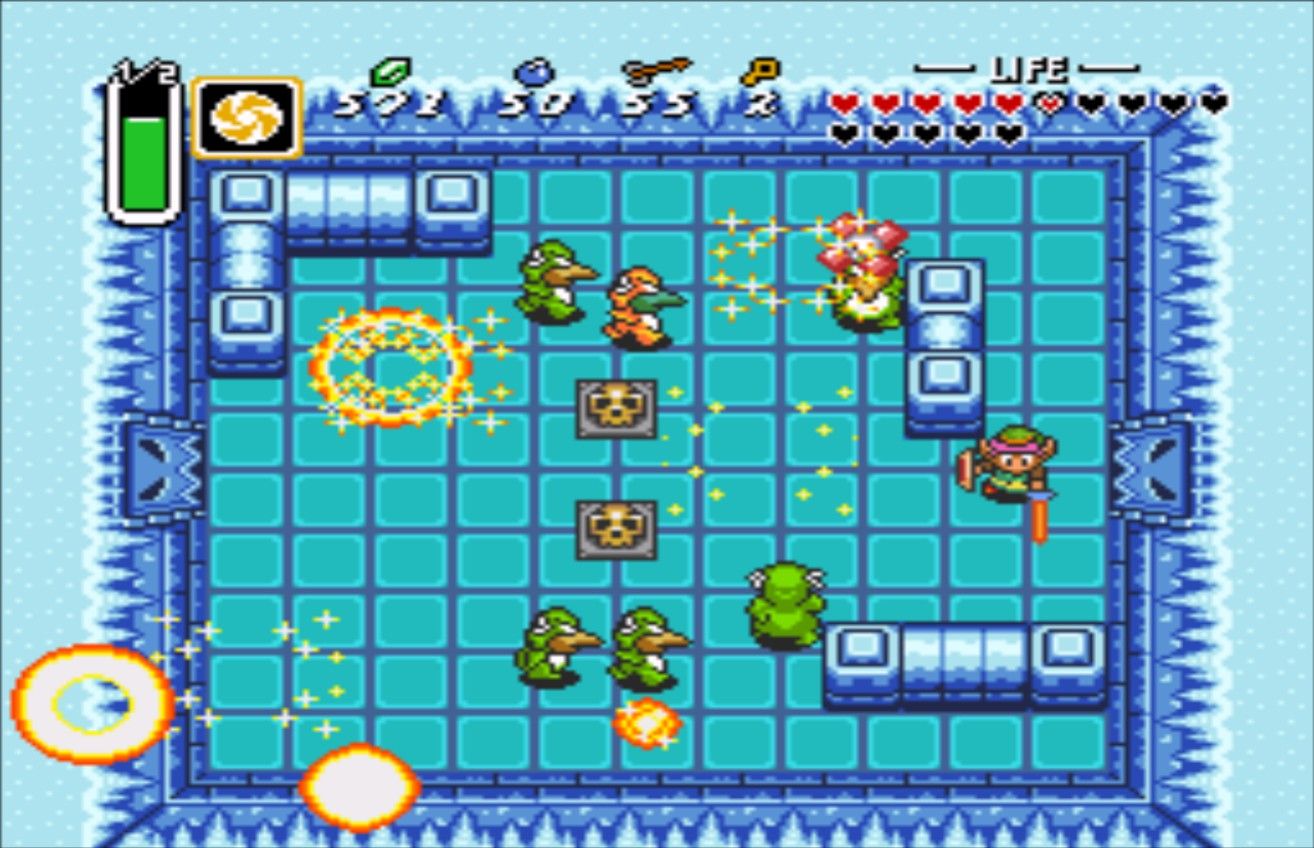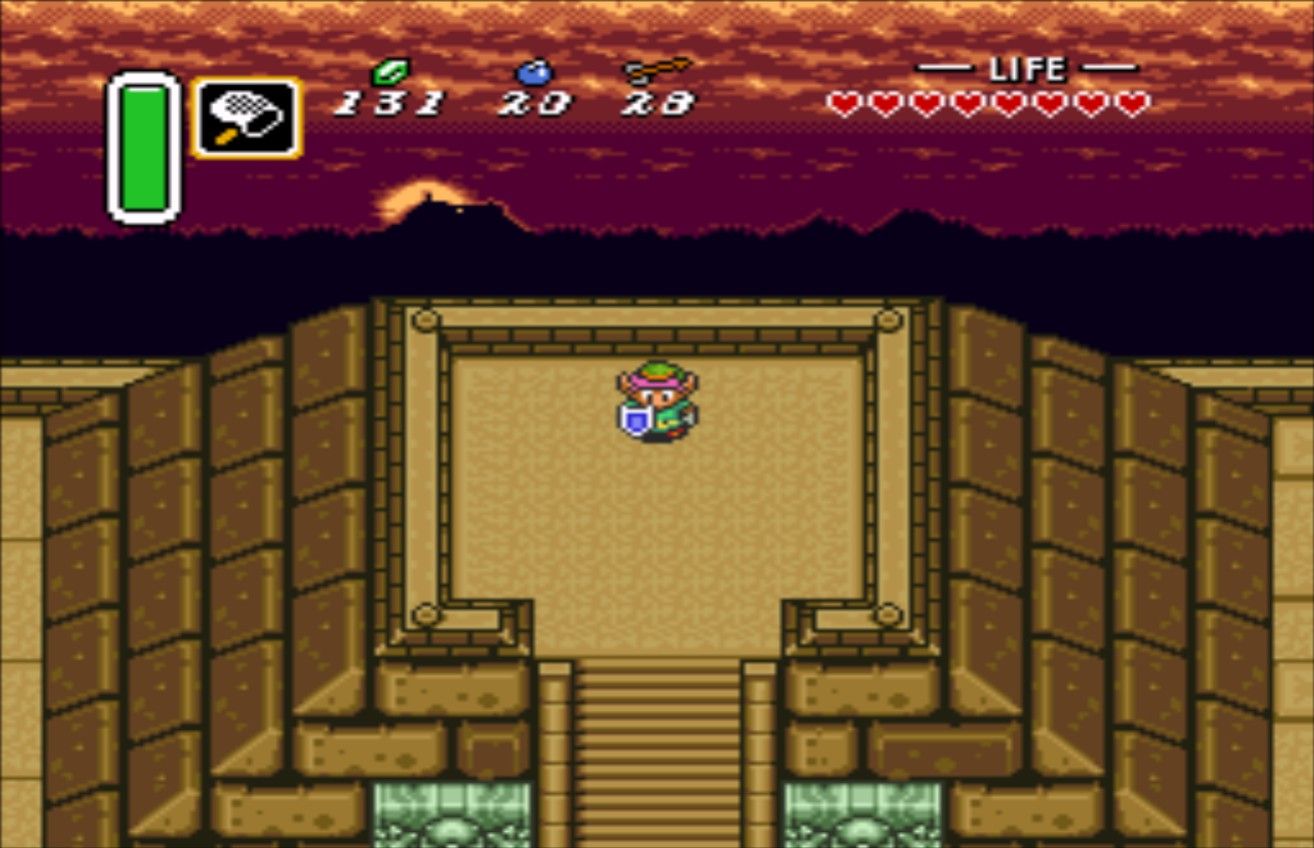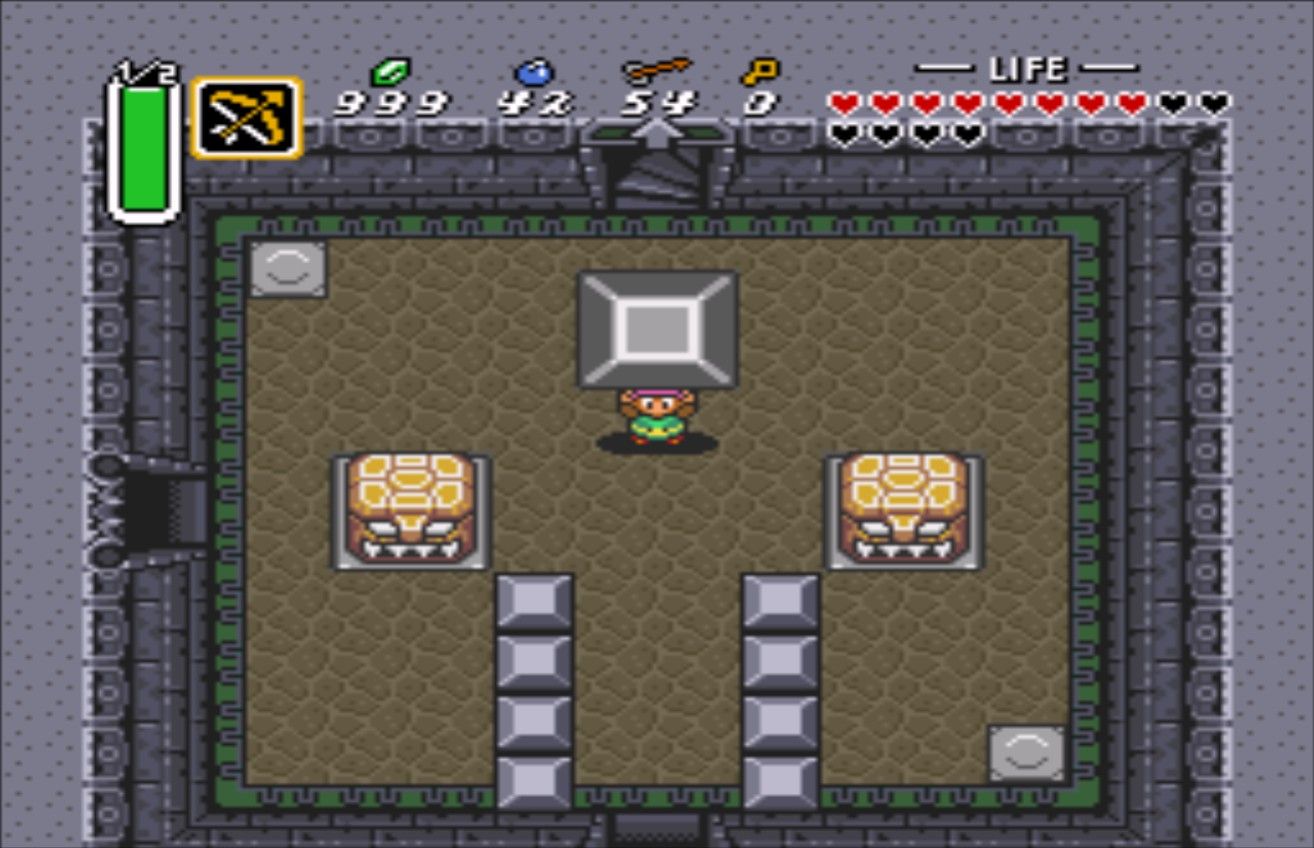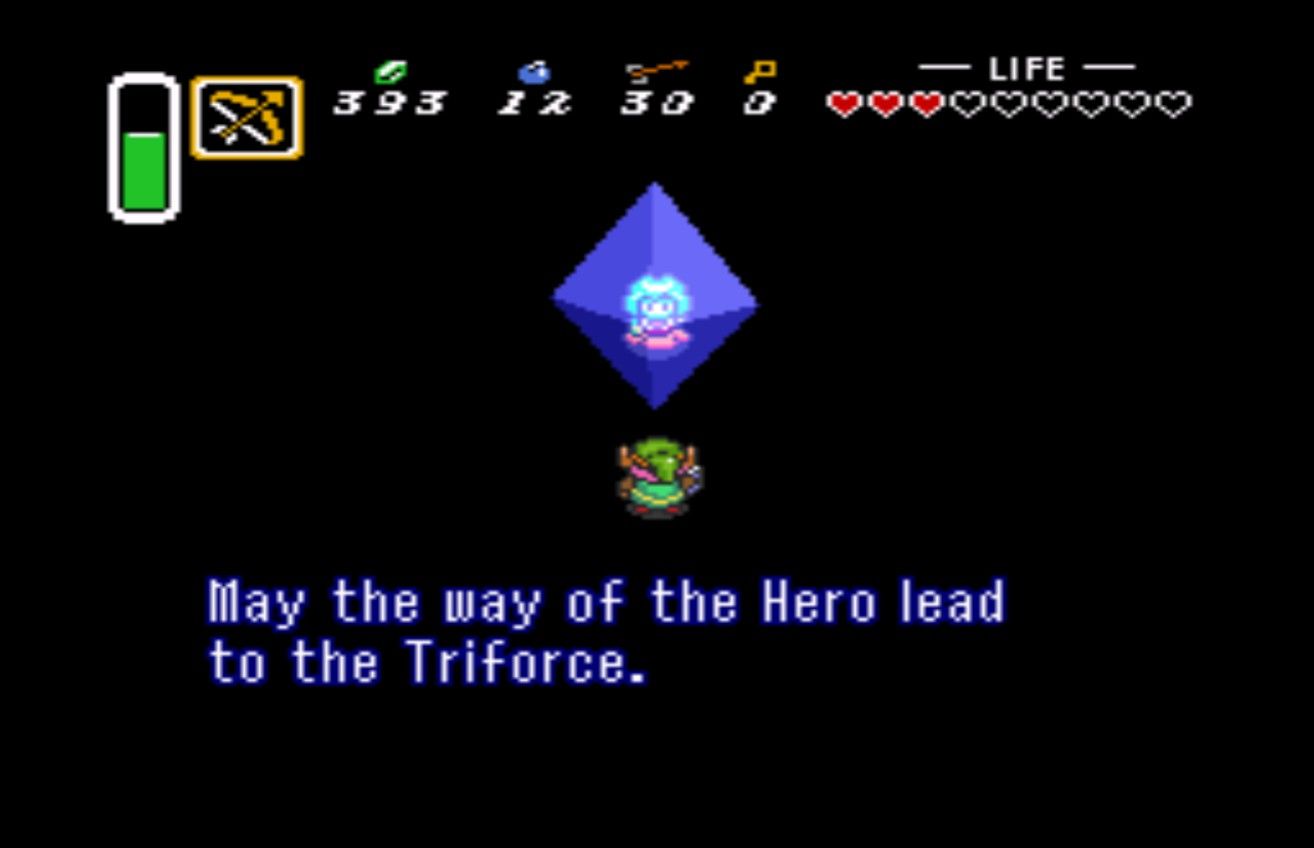Game Review: Legend of Zelda: A Link to the Past
This is my favorite Legend of Zelda game.
I think.
I know everyone thinks that Ocarina of Time is the best Zelda game and that it keeps winning polls as the best game of all time--with the notably infamous exception of last year at GameFAQs--but A Link to the Past has always been the game I went back to. My doubt is because of Wind Waker, but I won't be getting to that game for a while, so Link to the Past stands for the moment.
I never played it except briefly at friends' houses before emulation revealed the wonders of everything I missed by being a PC gamer, but I still got Nintendo Power through most of the Super Nintendo and part of the N64 era, and what I remember are the comics. Nintendo power serialized a comic based on A Link to the Past. Very loosely based--the constant vision, wings to fly into the desert, and balloon to get into Hyrule Castle had nothing to do with the game--but the game I imagined based on them was amazing. I still remember the story the tree tells Link about Ganondorf and the corruption of the Golden Land."Until then, I remain a fool in the shape of a tree."
Fortunately, though the game I eventually played was different, it was still excellent.

The graveyard is much more pastoral this time around.
Now I know that NPCs didn't come around with this game, instead being introduced in Zelda II, but this was my first real experience with them in the Legend of Zelda context. I remember loading up the game, Link's uncle going out into the rain, following him past all the guards as Zelda calls to Link, taking up the sword and shield, and then the same gameplay from the first Legend of Zelda, but now with 16-bit graphics and the ability to move diagonally. An expanded inventory! Bottles! Catching faeries in nets! All the extra tools!
I keep thinking that the basic template of the Legend of Zelda was set with A Link to the Past, but that's not strictly true. Later games hue closer to Ocarina of Time than they do to A Link to the Past, but A Link to the Past was the first form of that template. The themed temples, each of which has an item necessary to complete it hidden inside. Block puzzles. Items like the hookshot and the hammer. The template that future games either stuck to in order to really be a Zelda game or departed from to become an experimental offshoot, like Majora's Mask or Spirit Tracks.
There's always a princess. There's always a man. There's always a Triforce.

16-Bit Water Temple
One of the reasons I like A Link to the Past so much is that it introduces extra items. Unlike some of the more formulaic Zelda games, where each dungeon has one item, you get the items in the dungeons, and you know that if you find an item in a dungeon you need it to beat a dungeon, in this game there are items that just end up broadly useful. Like the Cane of Byrna, which makes you invincible but drains magic extremely quickly; or the Magic Cape, for slipping unseen through traps; or the
"Flute" (it's clearly an ocarina), for teleporting from place to place in the Light World. I'm a big fan of multiple possible solutions to problems, and the various extra items made some of those solutions possible. Charge past enemies, or sneak past them with the cape? Use the cane to beat a boss through a direct assault, or run and shoot arrows?
It does lead to a bit of bloat, though. Items like the Cane of Somaria obviously struggle to find much of a use and do fall victim to the "This dungeon is deisnged for Item X, after which you'll never use it again" problem. Though even then, the wiki just suggested using the cane's block as a test for invisible floors--create a block and push it. If the block falls, there's no floor there. So it's obviously not as useless as I thought, I'm just not as creative as I could have been. I kept using the Ether magic to reveal the path instead.
Hey, multiple solutions.

Massive explosions solve everything.
A Link to the Past has one of the better "It isn't over yet!" reveals, though reading Nintendo Power means that it was spoiled for me and didn't have nearly the effect on me that Final Fantasy VI would have later. You start the game and learn that Zelda has been kidnapped and you have to find the three pendants to get into the Hyrule Castle to get her back. The enemy is an evil wizard (in the Japanese, evil priest, but Nintendo and religion didn't mix in the 90s) named Aghanim, but that's not suspicious because in Zelda II Ganon doesn't show up and the final boss is Dark Link. And then you fight Aghanim and get sent to the Dark World.
The game isn't over.
An entirely separate map, with seven more dungeons, its own puzzles, and its own inhabitants. And I think it's when you get to the Dark World that A Link to the Past really begins, because once you find the Magic Mirror that lets you warp between the Light and Dark Worlds, you can use that to travel all over, get to previously inaccessibly areas, and open up entirely new possibilities by finding those optional items I mentioned earlier.
I know the genre is popularly called Metroidvania, but A Link to the Past really makes it easy to see how Castlevania: Symphony of the Night could have been inspired by Zelda the way Igarashi Kōji says it was.

Under a dying sun.
Another reason I like A Link to the Past so much is that it's not so spread out. Both Ocarina of Time and Wind Waker try to awe the player with the sheer quantity of space to cross. It's true that when I first played Ocarina of Time in 1998, riding Epona across Hyrule Field felt like an amazing leap forward in video game technology, and but my memories of it now are mostly that the field was huge, it was filled with gigantic peahats, and you had to ride through the whole thing every time you wanted to get anywhere. Same with Wind Waker, where the expansive ocean was very relaxing to sail through, but most of the islands were tiny without much to do and the warp points only helped so much.
A Link to the Past doesn't have any of that. It's extremely dense, so that even if there's nothing to do any any particular spot on the map, the only reason for that is because you've already done everything there is or you lack the tools to find out what you need to do there. Every time I loaded the game up with a destination in mind, I don't think it took me more than a couple minutes to get there once I had the Flute and the Magic Mirror. And speaking of the Flute, one of the extremely player-friendly choices the designers made is that every Flute drop-off point is near a warp to the Dark World. If you die in a dungeon and need to get more medicine, it will only take maybe five to ten minutes to leave, stock up, refill hearts, and return to the dungeon. Considering all the walking in the first two Zelda games and all the transportation in later games, A Link to the Past stands out as notably friendly.

Insert lifting joke here.
The actual dungeon design is very good. There's a clear ramp up in difficulty, with none of the three Light World pendant dungeons requiring any particularly difficult skills or puzzles and then the Dark World dungeons getting more and more difficult as you progress through the game. The major complaint I have is with all the pits. Like in Zelda II, a lot of the dungeons are pretty maze-like, with dead ends or ways to accidentally backtrack. Unlike Zelda II, in Link to the Past the backtracking includes one-way locking doors and pits that dump you to floors you've already been to, most of which either require an excellent memory or extensive mapping to avoid--checking the in-game map to see what room you're standing over before deciding which of three pits to jump into, for example--or a walkthrough to skip all the trial and error and save some time, which is what I did. I'm willing to figure out what block to push and what weapons to use to defeat enemies, but I draw the line at jumping randomly into pits and hoping that I picked the right one so I don't have to go through three rooms I've already cleared to get back to where I was.
On the other hand, the 2D nature of the dungeons means that this is really the only way that they're annoying. There's none of those "Walk into a room, doors close, loko around for the eye to shoot with an arrow to open the doors" situations that show up in later games, no fiddling with camera angles to figure out the right way to jump or how to get to a high ledge. Those seemed like innovations at the time, but now I just remember them as frustration.


I didn't have any doubt that A Link to the Past would hold up. I last played it about six years ago and I loved it then just as much as I loved it when I first played it. My main question is how well I'll think it holds up against the games I haven't played yet. Next up in my Legend of Zelda journey is Link's Awakening, and my only experience with that is reading about it in Nintendo Power, or Majora's Mask, which I've heard a lot of great things about but never even seen played, much less played it myself. Even if they're great, though, I don't know that they can unseat A Link to the Past as the best Zelda game for me. It's really a distillation of all the best Zelda tropes, with nothing extraneous and nothing missing.
I think.
I know everyone thinks that Ocarina of Time is the best Zelda game and that it keeps winning polls as the best game of all time--with the notably infamous exception of last year at GameFAQs--but A Link to the Past has always been the game I went back to. My doubt is because of Wind Waker, but I won't be getting to that game for a while, so Link to the Past stands for the moment.
I never played it except briefly at friends' houses before emulation revealed the wonders of everything I missed by being a PC gamer, but I still got Nintendo Power through most of the Super Nintendo and part of the N64 era, and what I remember are the comics. Nintendo power serialized a comic based on A Link to the Past. Very loosely based--the constant vision, wings to fly into the desert, and balloon to get into Hyrule Castle had nothing to do with the game--but the game I imagined based on them was amazing. I still remember the story the tree tells Link about Ganondorf and the corruption of the Golden Land."Until then, I remain a fool in the shape of a tree."
Fortunately, though the game I eventually played was different, it was still excellent.

The graveyard is much more pastoral this time around.
Now I know that NPCs didn't come around with this game, instead being introduced in Zelda II, but this was my first real experience with them in the Legend of Zelda context. I remember loading up the game, Link's uncle going out into the rain, following him past all the guards as Zelda calls to Link, taking up the sword and shield, and then the same gameplay from the first Legend of Zelda, but now with 16-bit graphics and the ability to move diagonally. An expanded inventory! Bottles! Catching faeries in nets! All the extra tools!
I keep thinking that the basic template of the Legend of Zelda was set with A Link to the Past, but that's not strictly true. Later games hue closer to Ocarina of Time than they do to A Link to the Past, but A Link to the Past was the first form of that template. The themed temples, each of which has an item necessary to complete it hidden inside. Block puzzles. Items like the hookshot and the hammer. The template that future games either stuck to in order to really be a Zelda game or departed from to become an experimental offshoot, like Majora's Mask or Spirit Tracks.
There's always a princess. There's always a man. There's always a Triforce.

16-Bit Water Temple
One of the reasons I like A Link to the Past so much is that it introduces extra items. Unlike some of the more formulaic Zelda games, where each dungeon has one item, you get the items in the dungeons, and you know that if you find an item in a dungeon you need it to beat a dungeon, in this game there are items that just end up broadly useful. Like the Cane of Byrna, which makes you invincible but drains magic extremely quickly; or the Magic Cape, for slipping unseen through traps; or the
"Flute" (it's clearly an ocarina), for teleporting from place to place in the Light World. I'm a big fan of multiple possible solutions to problems, and the various extra items made some of those solutions possible. Charge past enemies, or sneak past them with the cape? Use the cane to beat a boss through a direct assault, or run and shoot arrows?
It does lead to a bit of bloat, though. Items like the Cane of Somaria obviously struggle to find much of a use and do fall victim to the "This dungeon is deisnged for Item X, after which you'll never use it again" problem. Though even then, the wiki just suggested using the cane's block as a test for invisible floors--create a block and push it. If the block falls, there's no floor there. So it's obviously not as useless as I thought, I'm just not as creative as I could have been. I kept using the Ether magic to reveal the path instead.
Hey, multiple solutions.


Massive explosions solve everything.
A Link to the Past has one of the better "It isn't over yet!" reveals, though reading Nintendo Power means that it was spoiled for me and didn't have nearly the effect on me that Final Fantasy VI would have later. You start the game and learn that Zelda has been kidnapped and you have to find the three pendants to get into the Hyrule Castle to get her back. The enemy is an evil wizard (in the Japanese, evil priest, but Nintendo and religion didn't mix in the 90s) named Aghanim, but that's not suspicious because in Zelda II Ganon doesn't show up and the final boss is Dark Link. And then you fight Aghanim and get sent to the Dark World.
The game isn't over.

An entirely separate map, with seven more dungeons, its own puzzles, and its own inhabitants. And I think it's when you get to the Dark World that A Link to the Past really begins, because once you find the Magic Mirror that lets you warp between the Light and Dark Worlds, you can use that to travel all over, get to previously inaccessibly areas, and open up entirely new possibilities by finding those optional items I mentioned earlier.
I know the genre is popularly called Metroidvania, but A Link to the Past really makes it easy to see how Castlevania: Symphony of the Night could have been inspired by Zelda the way Igarashi Kōji says it was.

Under a dying sun.
Another reason I like A Link to the Past so much is that it's not so spread out. Both Ocarina of Time and Wind Waker try to awe the player with the sheer quantity of space to cross. It's true that when I first played Ocarina of Time in 1998, riding Epona across Hyrule Field felt like an amazing leap forward in video game technology, and but my memories of it now are mostly that the field was huge, it was filled with gigantic peahats, and you had to ride through the whole thing every time you wanted to get anywhere. Same with Wind Waker, where the expansive ocean was very relaxing to sail through, but most of the islands were tiny without much to do and the warp points only helped so much.
A Link to the Past doesn't have any of that. It's extremely dense, so that even if there's nothing to do any any particular spot on the map, the only reason for that is because you've already done everything there is or you lack the tools to find out what you need to do there. Every time I loaded the game up with a destination in mind, I don't think it took me more than a couple minutes to get there once I had the Flute and the Magic Mirror. And speaking of the Flute, one of the extremely player-friendly choices the designers made is that every Flute drop-off point is near a warp to the Dark World. If you die in a dungeon and need to get more medicine, it will only take maybe five to ten minutes to leave, stock up, refill hearts, and return to the dungeon. Considering all the walking in the first two Zelda games and all the transportation in later games, A Link to the Past stands out as notably friendly.

Insert lifting joke here.
The actual dungeon design is very good. There's a clear ramp up in difficulty, with none of the three Light World pendant dungeons requiring any particularly difficult skills or puzzles and then the Dark World dungeons getting more and more difficult as you progress through the game. The major complaint I have is with all the pits. Like in Zelda II, a lot of the dungeons are pretty maze-like, with dead ends or ways to accidentally backtrack. Unlike Zelda II, in Link to the Past the backtracking includes one-way locking doors and pits that dump you to floors you've already been to, most of which either require an excellent memory or extensive mapping to avoid--checking the in-game map to see what room you're standing over before deciding which of three pits to jump into, for example--or a walkthrough to skip all the trial and error and save some time, which is what I did. I'm willing to figure out what block to push and what weapons to use to defeat enemies, but I draw the line at jumping randomly into pits and hoping that I picked the right one so I don't have to go through three rooms I've already cleared to get back to where I was.
On the other hand, the 2D nature of the dungeons means that this is really the only way that they're annoying. There's none of those "Walk into a room, doors close, loko around for the eye to shoot with an arrow to open the doors" situations that show up in later games, no fiddling with camera angles to figure out the right way to jump or how to get to a high ledge. Those seemed like innovations at the time, but now I just remember them as frustration.


I didn't have any doubt that A Link to the Past would hold up. I last played it about six years ago and I loved it then just as much as I loved it when I first played it. My main question is how well I'll think it holds up against the games I haven't played yet. Next up in my Legend of Zelda journey is Link's Awakening, and my only experience with that is reading about it in Nintendo Power, or Majora's Mask, which I've heard a lot of great things about but never even seen played, much less played it myself. Even if they're great, though, I don't know that they can unseat A Link to the Past as the best Zelda game for me. It's really a distillation of all the best Zelda tropes, with nothing extraneous and nothing missing.